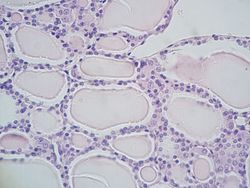Parafollicular cell
| Parafollicular cell | |
|---|---|

Histology section of the thyroid showing follicles, where parafollicular cells reside
|
|
| Identifiers | |
| Code | TH H3.08.02.4.00009 |
|
Anatomical terminology
[]
|
|
Parafollicular cells (also called C cells) are neuroendocrine cells in the thyroid which primary function is to secrete calcitonin. They are located adjacent to the thyroid follicles and reside in the connective tissue. These cells are large and have a pale stain compared with the follicular cells or colloid. In teleost and avian species these cells occupy a structure outside the thyroid gland named the ultimobranchial body.
Parafollicular cells are pale-staining cells found in small number in the thyroid and are typically situated basally in the epithelium, without direct contact with the follicular lumen. They are always situated within the basement membrane, which surrounds the entire follicle.
Recent research has confirmed that parafollicular cells are derived from endoderm. This is in contrast to the previously held belief that they were neural crest derived.
Until recently, parafollicular cells were believed to be derived from neural crest cells. Embryologically, they associate with the ultimobranchial body, which is a ventral derivative of the fourth (or fifth) pharyngeal pouch. In a series of experiments, neural crest cells were transplanted from quail, with unique and easily identified nuclei, into non-quail neural crest. The presence of cells with quail nuclei populating the ultimobranchial body was demonstrated, which raised the conclusion that C cells migrate during embryologic development from the neural crest.
Parafollicular cells secrete calcitonin, a hormone that participates in the regulation of calcium metabolism. It is important in fish and rodents, but its relevance in humans has not been demonstrated. Calcitonin lowers blood levels of calcium by inhibiting the resorption of bone by osteoclasts, and its secretion is increased proportionally with the concentration of calcium.
...
Wikipedia
